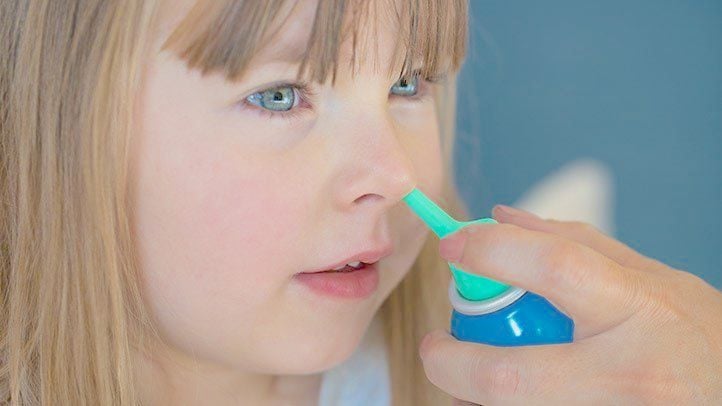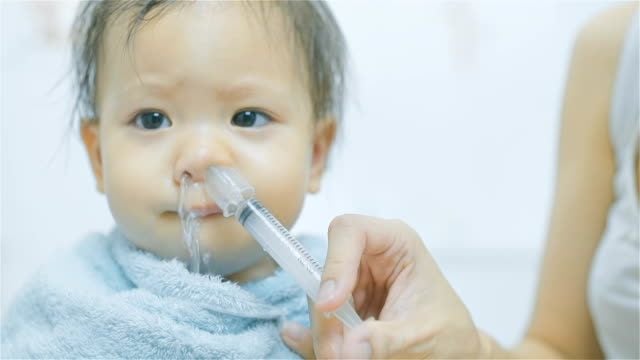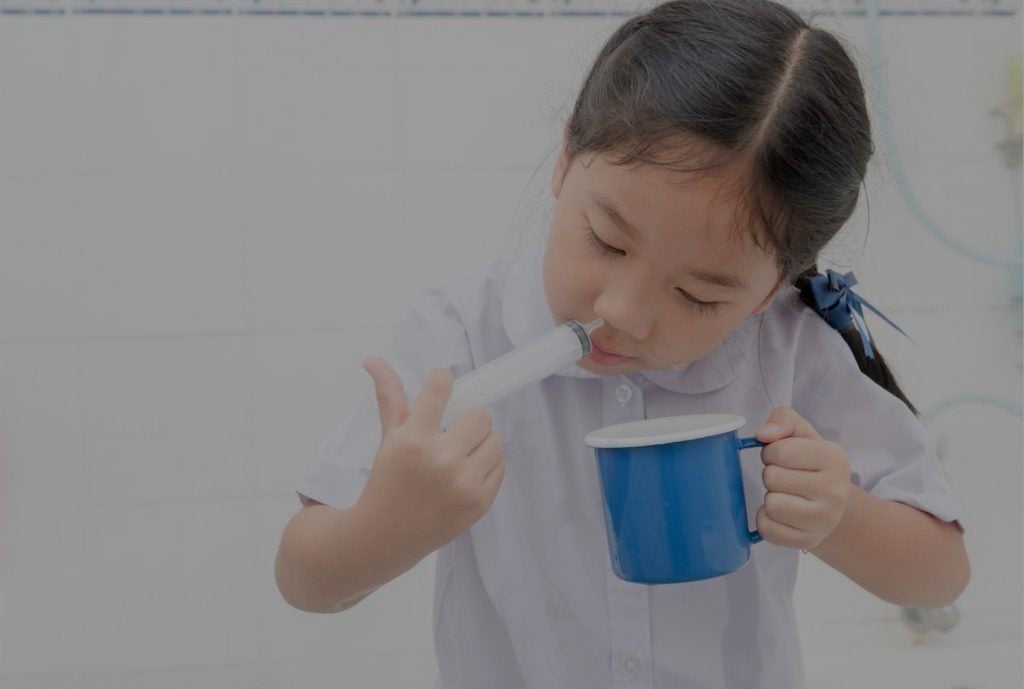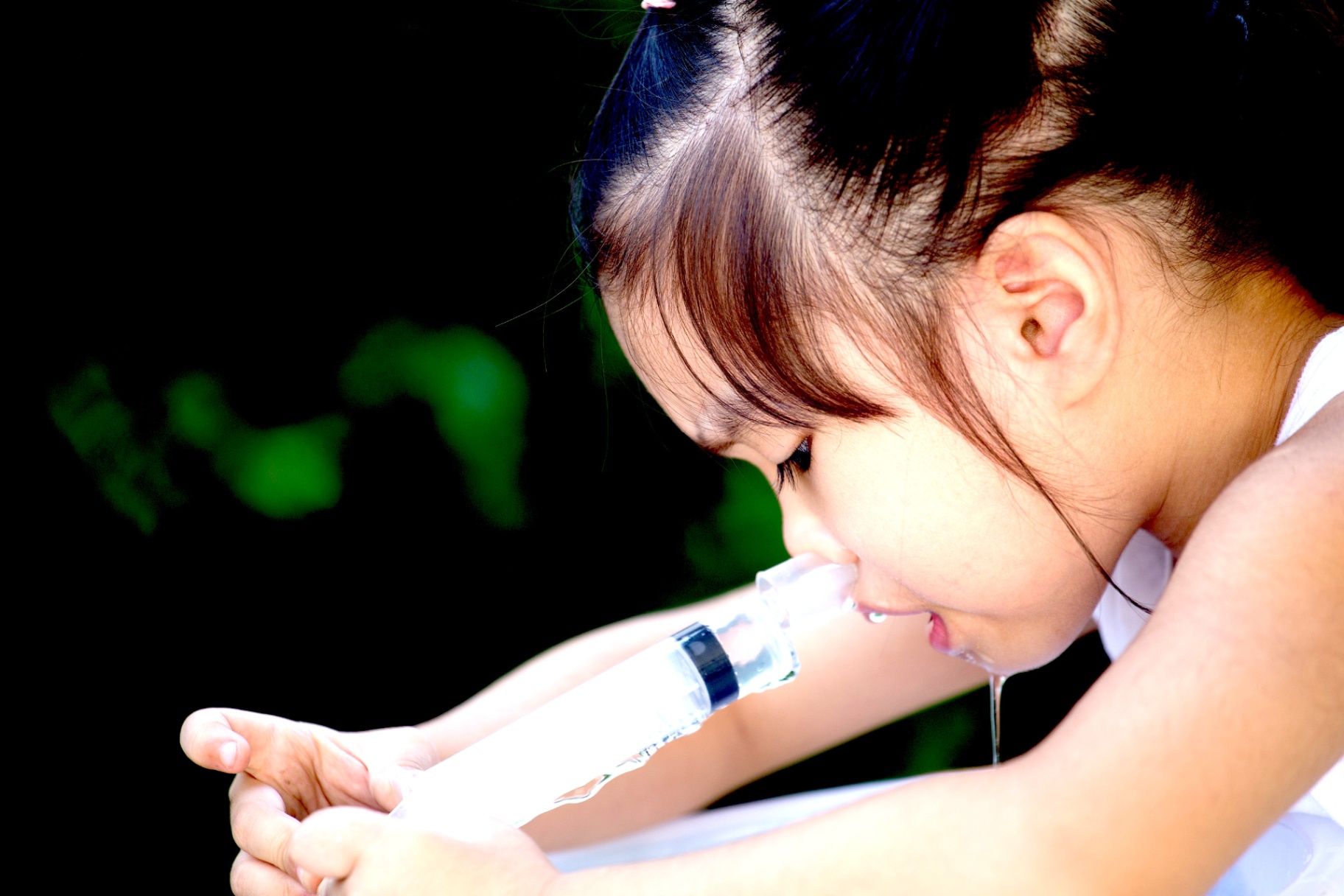Does your child have a stuffy or runny nose? Are they currently experiencing allergy symptoms and struggling to breathe? Caring for a child in this condition is uncomfortable for you and the child and requires special care.
If such symptoms are present in your child, a medical professional might recommend rinsing the child’s nose with saline solution in a process called nasal irrigation. It will help both of you to alleviate and ease the stuffy nose.
Few people know how to mix or use a saline solution for a stuffy nose, especially children. This article takes you through how to perform nasal irrigation on a child and how to make your saline solution at home.
- What Is a Nasal Saline Irrigation or Nasal Saline Rinse?
- How to Use a Saline Rinse on a Child
- Pros and Cons of Using a Saline Rinse
- How to Make a Saline Solution for Nasal Irrigation
- What to Do If Your Child Won’t Let You Near Their Nose

What Is a Nasal Saline Irrigation or Nasal Saline Rinse?
Nasal saline rinse or irrigation uses a salt and water mixture to flush dried mucus, thick mucus, and other debris out of the nostril to aid freer respiration from the nose. Using the saline solution for nasal irrigation is rooted in homeopathic medicine and yoga practices.

Common ailments where nasal irrigation is recommended include having a stuffy nose or runny nose. Acute and chronic rhinosinusitis are other medical conditions that a saline rinse can alleviate.
Despite its ease of use, people whose noses bleed easily should not use nasal irrigation. This also applies to people who don’t have an effective swallowing mechanism.
Saline solutions are easily accessible at your local pharmacy. However, if you can’t afford it or need a quick solution, you could make your solution at home by following the easy steps detailed later in this article.
Devices for Saline Solution Application
There are several devices for administering the saline solution nasal rinse. Manual devices such as a neti pot, syringe, and squeeze bottle are the most popular.
These devices spray or pour the saline mixture up the nostril, allowing the watery mucus to flow through the other nostril or the child’s mouth. As they’re pieces of medical equipment, you must keep your irrigation devices clean and ensure they’re free of bacteria before and after use.
No matter how clean you keep them, you can’t use your syringe or neti pot forever. Instead, you’ll have to change the devices every few months and buy a new one, much like a toothbrush.
How to Use a Saline Rinse on a Child
First, every drug or medical treatment must be administered with clean hands, so wash your hands thoroughly with soap or apply an alcohol-based sanitizer. Then fill your delivery container with the saline solution and have your child stand over a bowl or sink.

If you’re using a syringe, insert the opening just at the entrance of the nostril, leaving the child’s mouth open and the other nostril free. Next, gently squeeze the syringe with your aim towards the back of the child’s head and not upward.
The water pushed through the first nostril will either come out through the mouth or the second nostril. So, your child’s mouth and other nostrils should be left open, not closed. Once that’s done, have your child blow their nose and rinse their mouth, except if the doctor asks them not to.
Ask a medical practitioner for added guidance in administering the treatment. If an emergency occurs, do not hesitate to call an ambulance for help.
How to Prepare Your Child for the Treatment
Dealing with children can be complicated, especially when it concerns medical treatment. They are delicate beings who may not immediately understand what’s going and you, the adult, also need to know what you’re doing and be able to handle tantrums.
To ensure a smooth application of the saline rinse, you need to understand the process first and then explain it to your little one. You should explain the process and benefits to your child in simple terms. Once your child has soaked in the information and is ready, you can use a nasal spray to wet the nose.
You should also help them understand that they might feel a burning sensation during the process, but it’s not harmful. It’s imperative to provide verbal and physical comfort when needed.
Pros and Cons of Using a Saline Rinse
A significant benefit of using a saline rinse is that it’s often a quick way to decongest the nostrils, reduce nasal dripping, and aid smoother respiration. It not only works for children but adults as well. In addition, a saline rinse keeps the nasal way healthy and helps to prevent nasal infections.

Nasal saline irrigation also improves the functions of the tiny hairs in the nostrils (cilia) that stop unwanted agents from entering the body through the nose. By extension, it keeps the nasal way healthy and free of dried crust or dried or thick mucus.
This treatment also has its disadvantages. The saline solution might wash away helpful antiviral, antifungal, and antibacterial agents while clearing the sinuses. These are usually the first line of defense against nasal diseases—without them, you’re vulnerable.
That’s why you shouldn’t form an over-dependence on the nasal irrigation method. Over time, you might be causing more harm than good, and this relief method can become counterproductive for your child’s health.
Do’s and Don’ts of Using a Saline Solution on a Child
Research shows that most people find using distilled or bottled water inconvenient, as opposed to using unboiled tap water. Kindly avoid using unboiled tap water or ocean water to mix the solution, or you might put your child at risk of a condition called meningoencephalitis.
Ensure you follow the measurements strictly. For example, due to the low salt concentration, a saline solution shouldn’t sting. When it does, it means the salt content is too much.
Also, if your child needs to take additional nasal medication, you should administer the saline irrigation before the other medicines. If the medicine is applied first, the saline solution could wash the medication away and reduce its effectiveness.
How to Make a Saline Solution for Nasal Irrigation
You might not be able to reach a pharmacy to get an already prepared saline solution. In that case, you might have to make yours at home.

You’ll need a clean container, non-iodized salt, baking soda, and distilled water (or tap water boiled and allowed to cool). Also, make sure you have an air-tight container with a lid, for example, a bottle, and a clean utensil to mix it all together.
When you have all these items, it’s time to make your homemade saline solution. Start by washing your hands properly and sterilizing the mixing container and utensils by boiling them in water or washing them with a dishwasher.
Follow this by mixing three spoons of salt and one tablespoon of baking soda in a separate bowl. You should also add one tablespoon of the mixture into the sterilized bowl and pour in a cup of water. Stir until the solids are dissolved and pour it all into the syringe to use immediately or store for later.
How to Store Your Saline Solution
It’s essential to store your saline solution properly to avoid bacteria growth. Research from the National Library of Medicine suggests that the best storage method for your homemade solution is in the refrigerator.
Research conclusions showed no bacterial activity in the saline solution stored in the refrigerator. On the other hand, saline solution stored at room or ambient temperature had a higher occurrence of pathogenic bacterial growth.
When there’s no refrigerator available, the solution should be hypertonic or isotonic and made with bottled or distilled water.
What to Do If Your Child Won’t Let You Near Their Nose
The last thing a child or anyone wants to do when you’re sticking something up their nose is to sit still and smile. If your child sits calmly, lucky for you. If not, there are a few things you can do.

A humidifier with only water can help to loosen up mucus gradually. Try not to add anything to the water as it might irritate the nose further and trigger more mucus production.
Keep in mind that, where it concerns you or your child’s health, convenience should be the last thing to consider. Maintain patience and always do what’s best for the child. For example, if they’d be better off with prescribed drugs, you could present it as a better option.
Over-the-counter medication can also provide some relief for your child. Consult your doctor or the pharmacist on duty about the specific drug you should get.
Other Uses of Saline Solution
Saline solution isn’t limited to flushing the nose and clearing out nasal congestion. Saline solutions are also used to ease off sore throat symptoms with a saline solution gargle.
It is also a cost-effective method for disinfecting wounds in an emergency or regular cleaning at home. For people using catheters to pass urine, bladder irrigation with saline solutions can clear passageways.
Lastly, saline irrigation helps to protect piercings and contact lenses from bacteria. Soak your piercings and contact lenses in a saline solution for a good clean and disinfection.
Conclusion
Caring for a child when they’re sick or can’t breathe freely can be distressing. A saline solution can help alleviate congested nostrils and help them feel better. Ensure all instruments used are clean and make sure your child understands what the treatment is for.
Suppose your child refuses to let you administer the saline solution. In that case, you may want to try other solutions like over-the-counter medication. Contact a doctor before using this method on your child and in case of medical emergencies.







